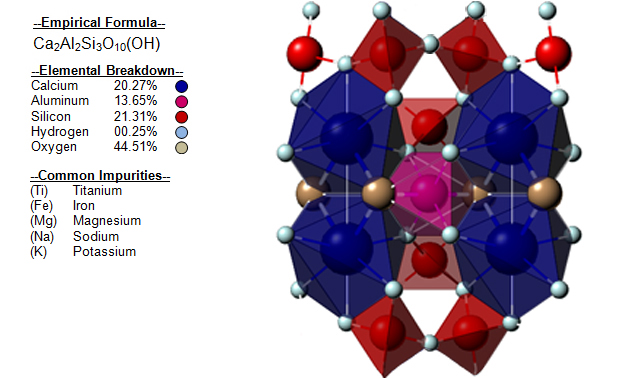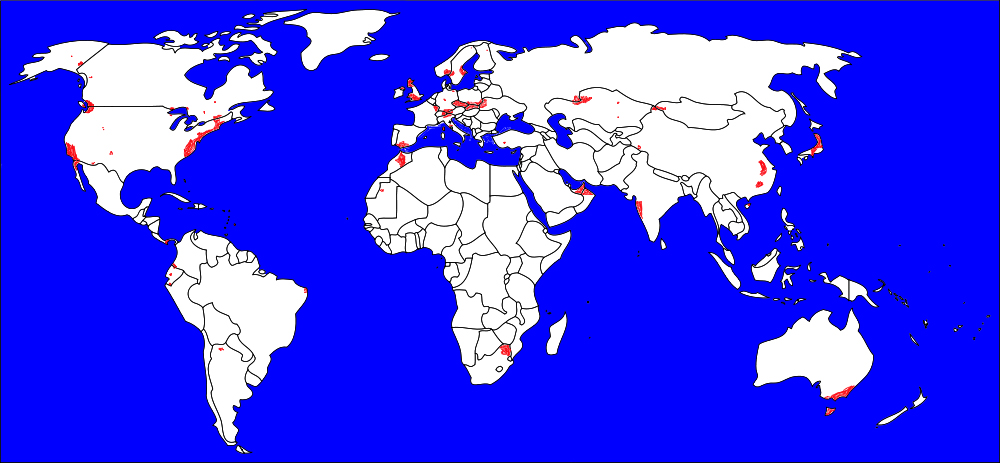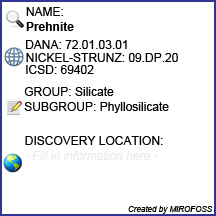

| Mineral Name | Prehnite |
| First Discovered | 1788 |
| Nickel-Strunz Classification | 09.DP.20 |
| Dana Classification | 72.01.03.01 |
| ICSD | 69402 |
| Mineral Group | Silicates |


| Cleavage | Distinct |
| Colour(s) | Colourless, Gray, Yellow, Yellowish green, White |
| Specific Gravity | 2.87 |
| Diaphaneity | Sub-transparent to Translucent |
| Fracture | Brittle - Generally displayed by glasses and most non-metallic minerals |
| Mohs Hardness | 6.0 to 6.5 |
| Luminescence | Fluorescent, Short UV - blue,white, peach, Long UV - Yellow |
| Luster | Vitreous to Pearly |
| Streak | Colourless |
| Habit(s) | Globular to Reniform to Stalactic |
| Radioactivity | Non-radioactive |
| Magnetism | Non-magnetic |

No known health risks have been associated with prehnite. However ingestion of prehnite, as with other naturally occurring minerals, is not recommended.

The following image shows the elemental breakdown of the mineral prehnite along with the mineral crystal structure.


| Crystal System | Orthorhombic |  |
| Class | Pyramidal | |
| Axial Ratios | a : b : c = 0.8427 : 1 : 3.3784 | |
| Twinning | Fine lamellar | |
| Optical Data Type | Biaxial (+) | |
| Pleochroism (x) | Colourless | |
| Pleochroism (y) | Colourless | |
| RL Values | nα = 1.611 - 1.632 nβ = 1.615 - 1.642 nγ = 1.632 - 1.665 | |
| 2V | Measured: 64° to 70°, Calculated: 58° to 68° |  |
| Max Birefringence | δ = 0.021 - 0.033 (See colour chart at right) | |
| Surface Relief | Moderate | |
| Dispersion | Weak r > v | |

Prehnite can be referenced in certain current and historical texts under the following ten names:
The mineral prehnite can be translated into the following select languages:
| Arabic | Bulgarian | Chinese (Sim) | 葡萄石 | ||
| Croatian | prehnit | Czech | Danish | prehnit | |
| Dutch | Prehniet | Esperanto | Estonian | ||
| Finnish | French | Chrysolite du Cap | German | Prehnit | |
| Greek | Hebrew | Hungarian | Prehnit | ||
| Italian | Prehnite | Japanese | ぶどう石 | Korean | 프레 나이트 |
| Latin | Lithuanian | Norwegian | |||
| Persian | Polish | Prehnit | Portuguese | ||
| Romanian | Russian | Пренит | Slovak | ||
| Spanish | Prehnita | Swedish | Tagalog | ||
| Turkish | prehnit | Ukrainian | Дебати | Vietnamese |

Prehnite can be found in many places around the world. The map below shows major documented concentrations of prehnite:


 |
The MIROFOSS database offers free printable geological identification tags for personal and non-profit use. These tags can be used to properly identify mineral samples in your collection. -Click here- to download a full size jpeg image for a wollastonite identification tag; which can be printed on paper or used with a plastic laser printer. |
 |
What's this? What can I do with it? |

| Chemical Composition | Hurlbut, Cornelius S.; Klein, Cornelis, 1985, Manual of Mineralogy, 20th ed., ISBN 0-471-80580-7 |
| Crystallography | F. Aumento (1968): The space group of prehnite. Can. Mineral. 9, 485-492. |
| History | European Journal of Mineralogy (1990): 2: 731-734. |
| History | Canadian Mineralogist (1987): 25: 707. |
| Geographical Data | Mindat.org. Retrieved on 2012-01-17 |
| Physical Identification | Webmineral.com. Retrieved on 2012-01-17. |
| January 17, 2012 | The last time this page was updated |
| ©2017 MIROFOSS™ Foundation | |
 |